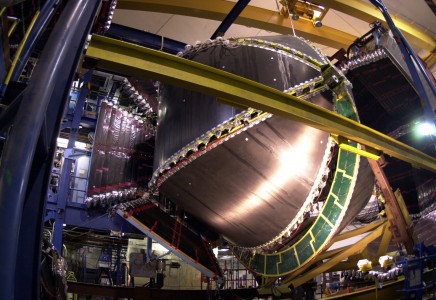Fast-Moving Nucleons May Solve 35-Year-Old Mystery

Jefferson Lab's Experimental Hall B, featuring the CEBAF Large Acceptance Spectrometer.
Additional Links
Physicists develop a universal function that suggests that proton-neutron pairs in the nucleus may explain why quarks inside nuclei have lower average momenta than predicted.
The Science
A careful re-analysis of data from an unrelated experiment conducted in 2004 has led to the extraction of a universal function that successfully describes short-range correlations, which are fleeting partnerships formed between protons and neutrons inside the nucleus. The function also suggests that these short-range correlations may explain a 35-year-old mystery in nuclear physics.
The Impact
First discovered over 35 years ago by the European Muon Collaboration, the EMC Effect was an unexpected discovery that quarks inside nuclei have lower average momenta than predicted. The new universal function describes the EMC Effect and suggests that it can be explained by proton-neutron pairs in the nucleus.
Summary
The EMC Effect was first discovered more than 35 years ago by the European Muon Collaboration in data taken at CERN. The collaboration found that quarks inside a nucleus appeared different from those found in free protons and neutrons. Physicists developed two main models to explain this phenomenon. One model is that all protons and neutrons in a nucleus, and thus their quarks, are modified in the same way by being bound inside a nucleus. The other model is that many protons and neutrons behave as if they are free, while about one-fifth are involved in short-range correlations and are highly modified. The latter model is now supported by a new result from a careful re-analysis of data from an experiment conducted in 2004 using Jefferson Lab’s Continuous Electron Beam Accelerator Facility. CEBAF probed the nuclei of carbon, aluminum, iron and lead as compared to deuterium (an isotope of hydrogen containing a proton and neutron in its nucleus). Comparing the data, a pattern emerged, and the researchers derived from this information a universal modification function for short-range correlations, the brief pairing of protons and neutrons in nuclei. They then applied the function to the nuclei used in measurements of the EMC Effect, and they found that it was the same across all measured nuclei. The physical picture of short-range correlations as the cause of the EMC Effect also accomplishes another step toward a long-time goal of nuclear and particle physicists to connect two different views of the atom’s nucleus: as it being made up of protons and neutrons, versus their constituent quarks. The universal function will be tested directly in the future using lattice quantum chromodynamics (QCD) calculations and by a future experiment in Hall C at Jefferson Lab that will study directly the relationship of the EMC effect and short-range correlations in the deuteron.
Contact
Or Hen
Massachusetts Institute of Technology
hen@mit.edu
Larry Weinstein
Old Dominion University
weinstein@jlab.org
Funding
The research was supported by the U.S. Department of Energy’s Office of Science. It was also supported by the National Science Foundation, the Israel Science Foundation, the Chilean Comisión Nacional de Investigación Científica y Tecnológica, the French Centre National de la Recherche Scientifique and Commissariat a l’Energie Atomique the French-American Cultural Exchange, the Italian Istituto Nazionale di Fisica Nucleare, the National Research Foundation of Korea, and the UK’s Science and Technology Facilities Council.
Publications
The CLAS Collaboration, "Modified structure of protons and neutrons in correlated pairs." Nature 566 354 (2019).
https://doi.org/10.1038/s41586-019-0925-9
Related Links
Correlated Nucleons May Solve 35-Year-Old Mystery
Protons Get Zippier in Neutron-Rich Nuclei
Protons Hog the Momentum in Neutron-Rich Nuclei
February 2019

